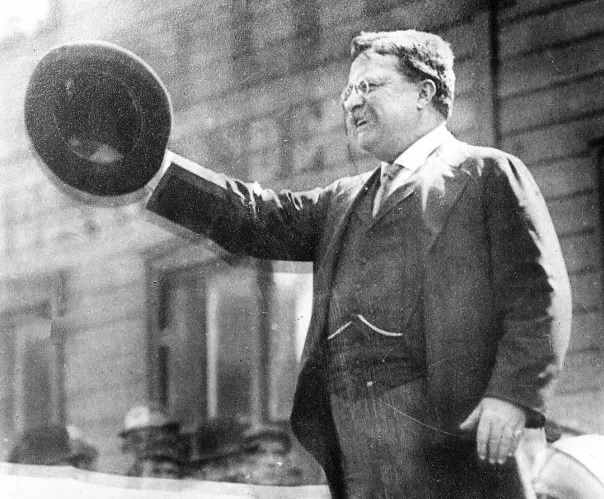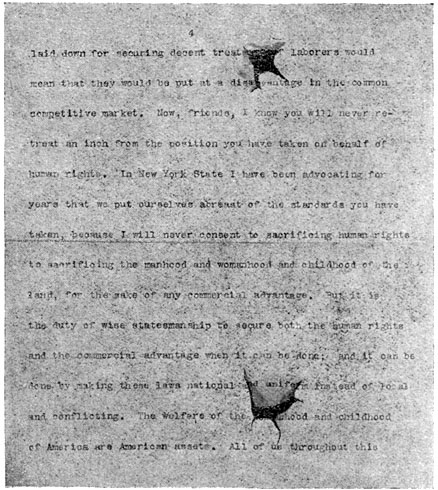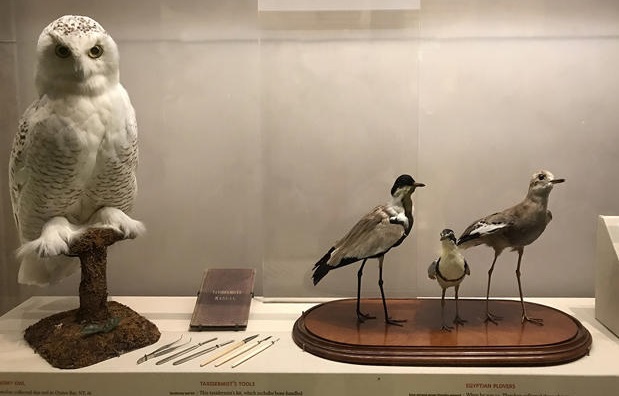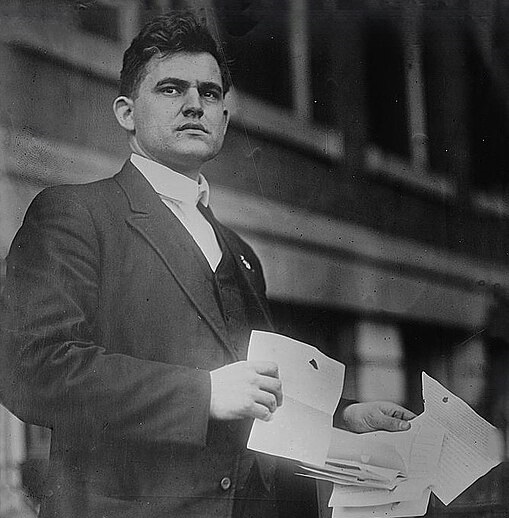In 1912, a former U.S. President, after being out of office for a term, became a Presidential candidate, and that candidate was shot by a would-be assassin at the outset of a campaign speech.
The former President was Theodore Roosevelt, nicknamed ‘the Bull Moose’, and he had been fighting a bitterly contested campaign. He himself succeeded an assassinated President; when William McKinley was shot in 1901 Roosevelt had ascended to the Presidency, winning it again in his own right in 1904. Retiring from public office, he was succeeded in 1908 by William Howard Taft, but over the years, Roosevelt had come to despise the man. The feeling was mutual. Roosevelt had come to Milwaukee on the evening of October 14th, the second state of the day in his aggressive campaign schedule (Chicago and Racine, Wisconsin were previous stops). Standing up in his car to wave to supporters, a former saloonkeeper named John Schrank stepped forward, less than five feet away from his target, and shot him directly in the chest.
Schrank had purchased a .38 caliber revolver when he had decided to kill Roosevelt. He’d followed the candidate from state to state for more than three weeks, never getting close enough to act, but his opportunity came on October 14th. He only managed to fire a single shot, though it was not a Secret Service agent but a stenographer who stopped him from shooting again; Roosevelt’s aide Elbert Martin tackled Schrank and wrestled him to the ground. The former President did not lose consciousness and kept his wits about him. Providentially, Roosevelt had his 50-page speech folded in half and the steel case for his pince-nez (a type of eyeglasses that don’t have earpieces) in his coat pocket, both of which slowed the bullet substantially before it entered the right side of his chest, at the fourth rib.
Roosevelt was an outdoorsman; he had been a cattle rancher, hunter, taxidermist, and served in the “Rough Riders” 1st United States Volunteer Cavalry in the Spanish–American War. His lifetime of experiences with inflicting and treating wounds prepared him to accurately diagnose how severe his own chest injury was; since no blood was coming out of his mouth, he knew his lungs were unharmed and refused to cancel his speech. The Secret Service existed at the time and had been assigned the job of protecting Presidents and Presidential candidates after McKinley’s death, but their methods and authority to override the decisions of their charge were less developed than in modern times. The candidate got his way. Roosevelt demanded that the would-be assassin be brought to him (saving the man from a lynching in the process), and questioned him briefly, before deeming him to have a weak mind and dismissing him as a ‘poor creature’.
Roosevelt’s diagnosis of Schrank’s mental state was as accurate as his diagnosis of his own wound. Schrank had been having hallucinations of the ghost of President McKinley, demanding that his death be avenged and indicating Roosevelt as the man to blame for it. He also opposed the idea of Roosevelt serving a third term, when George Washington had only served two (an informal tradition that all other Presidents at that time had honored, and which would eventually be formalized in the 22nd Amendment). Wrestling with the implications of violating the commandment “you shall not murder”, he eventually decided that as an assassin, he would be acting as an agent of God and that this would exempt him. Although Schrank pled guilty of his crime, the judge, August Backus, didn’t think the defendant was mentally fit and refused his guilty plea. On the advice of a panel, he was instead committed to the Central State Hospital for the Criminally Insane. He would die there 31 years later, having never received a visitor.
Meanwhile, Roosevelt proceeded to the Milwaukee Auditorium. Revealing to his audience of 9,000 he had been shot, he famously quipped “it takes more than that to kill a Bull Moose.” He proceeded to deliver the entire hour-long address before finally allowing himself to be taken to a hospital. Roosevelt suggested in his speech that the incessant and inflamed rhetoric in the “yellow journalism” newspapers of the day influenced the assassin to action:
I wish to say seriously to all the daily newspapers, to the Republican, the Democratic and the Socialist parties, that they can not, month in and month out and year in and year out, make the kind of untruthful, of bitter assault that they have made and not expect that brutal, violent natures, or brutal and violent characters, especially when the brutality is accompanied by a not very strong mind; they can not expect that such natures will be unaffected by it.
When Roosevelt finally consented to go to the hospital (first Johnston Emergency Hospital in Milwaukee, then Mercy Hospital in Chicago), he was treated by doctors all too aware that McKinley had died from an infection from his surgery after being shot, and not from the bullet itself. They determined that it was less dangerous to leave the bullet in his chest, and it was not removed. When asked about it, Roosevelt’s reply was “I do not mind it any more than if it were in my waistcoat pocket.” Days after the shooting, on October 27th, he celebrated his fifty-fourth birthday. He was back on the campaign trail by October 30th.
Many of the artifacts associated with the assassination attempt are now maintained in archives, libraries, or museums. Elbert Martin carefully collected the discarded pages of Roosevelt’s speech that day – it was Roosevelt’s practice to drop them on the floor as he finished with each page, and let people take them as souvenirs. The speech, along with the bullet-damaged pince-nez case and Roosevelt’s bloodstained shirt, are currently displayed at the Roosevelt Birthplace Museum in New York by the U.S. National Park Service. Shrank’s trial records and court exhibits are held by the Milwaukee Public Library. Roosevelt’s personal papers, including telegrams and correspondence related to the assassination attempt, are not housed in a single presidential library, as is the modern practice, but are held by many libraries and universities throughout the country. Some material is held privately; Roosevelt gave Schrank’s revolver and an inscribed watch to Elbert Martin in thanks for his quick action.
To learn more about Roosevelt and the assassination attempt, databases like American History Online and Ebook Central include primary sources, articles, biographies, books, and videos about the Bull Moose in addition to those linked above. If you want more, you can also Ask Us at iueref@iu.edu.






